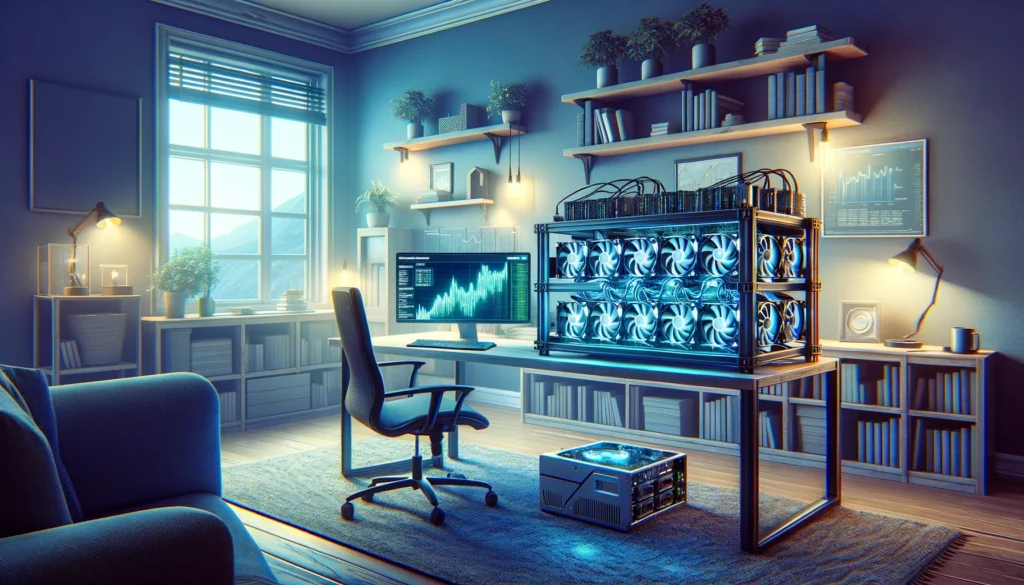Cryptocurrency mining uses computer hardware to perform complex calculations that validate and record transactions on a blockchain network. This activity not only supports the functionality and security of the blockchain but also offers miners the chance to earn cryptocurrency as a reward. It’s akin to solving complex puzzles, where success brings digital currency rewards.
Why Set Up a Home Mining Rig
Setting up a home mining rig can be a rewarding venture. It offers a hands-on approach to understanding the world of cryptocurrency. Beyond potential earnings, it’s an educational journey into the technical aspects of digital currencies and blockchain technology.

Preparing for Your Mining Journey
To start mining, you’ll need a few critical components: a powerful computer or mining rig, specialized mining software, and a stable internet connection. The heart of your mining operation is the rig, which can be built from scratch or purchased pre-assembled.
Budget Considerations
Costs can vary widely based on the scale and efficiency of your setup. A basic rig can cost a few hundred dollars, but more powerful setups can run into thousands. Additionally, consider ongoing costs like electricity, as mining is power-intensive.
Choosing the Right Hardware CPU vs. GPU vs. ASIC Miners
You can mine with a CPU (Central Processing Unit), GPU (Graphics Processing Unit), or an ASIC (Application-Specific Integrated Circuit). CPUs are the least powerful and, thus, the least efficient. GPUs, used in gaming computers, are more powerful and versatile. ASICs are the most efficient but are expensive and limited to mining specific cryptocurrencies.
Selecting the Best GPU for Mining
When choosing a GPU, consider factors like hash rate (mining power), power consumption, and cost. Popular choices include NVIDIA and AMD graphics cards. Higher hash rate and lower power consumption translate to better efficiency and profitability.
Assembling the Hardware
Assembling a mining rig involves connecting the motherboard, processor, RAM, graphics cards, power supply, and storage. It’s similar to building a PC but with a focus on the number and type of GPUs.
Installing and Configuring Mining Software
Choose mining software compatible with your hardware and the cryptocurrency you wish to mine. Examples include NiceHash and Claymore. Configuration involves setting up the software to connect to a mining pool and optimizing settings for maximum efficiency.
Fine-Tuning for Optimal Performance
Optimizing involves adjusting GPU settings like clock speed and power limits to balance performance and energy consumption. Tools like MSI Afterburner can help in fine-tuning these settings.
Managing Heat and Noise
Effective cooling is crucial as mining generates significant heat. Consider additional cooling solutions like custom fans or air conditioning. Soundproofing can also be beneficial if noise is an issue.
Mining Pool vs. Solo Mining
Mining pools combine the computational power of several miners, increasing the chances of earning rewards. While rewards are shared, resulting in smaller individual payouts, pools offer more consistent earnings than solo mining.
How to Choose a Mining Pool
Factors include pool size, payout structure, fees, and the pool’s reputation. Larger pools offer more regular payouts but smaller amounts. Payout structures can be proportional or pay-per-share, impacting your earnings.
Securing Your Mining Setup
Security involves both physical and digital measures. Physically secure your rig against theft or damage. Digitally, use strong passwords, secure wallets, and consider additional measures like hardware wallets for storing significant amounts of cryptocurrency.
Regular Maintenance and Troubleshooting
Regularly check your rig for dust buildup, ensure the software is up to date, and monitor performance for any anomalies. Troubleshooting common issues like overheating or connectivity problems is part of regular maintenance.
Conclusion
Entering the world of cryptocurrency by setting up a mining rig at home can be technically challenging and initially expensive, but it can also be an engaging experience.

